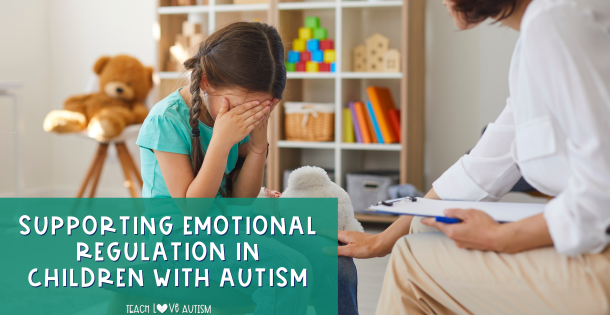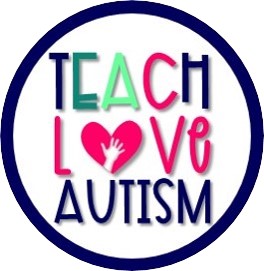Supporting Emotional Regulation in Children with Autism
Sharing is caring!

Strategies to Help Manage Meltdowns, Anxiety, and Sensory Overload at Home and School
Emotional regulation in children with autism is a critical skill for all, but it can be particularly challenging. Difficulty processing emotions, sensory sensitivities, and communication barriers can lead to meltdowns, anxiety, and emotional overload. However, with the right strategies in place, parents and teachers can support emotional regulation in children with autism in developing emotional regulation skills that improve their well-being and daily interactions. Here are some practical strategies to help manage emotional challenges at home and in the classroom.
Understanding Emotional Regulation in Autism
For many children with autism, the world can feel overwhelming. We talk about this a lot in my Facebook group called the “Teach Love Autism Community“. There are so many things happening all at once—loud noises, bright lights, changing expectations—and it can be difficult to process everything while also managing emotions. That’s why emotional regulation in children with autism is such a crucial skill. Unlike neurotypical children who might naturally develop coping strategies, children with autism often need explicit instruction and structured support to regulate their emotions effectively.
It’s important to remember that meltdowns are not the same as tantrums. A tantrum typically happens when a child wants something, but a meltdown occurs when the child is overwhelmed and cannot control their response. Understanding this distinction helps approach emotional regulation in children with autism with patience, empathy, and the right tools to provide meaningful support.
Strategies for Managing Emotional Regulation
1. Establish Predictable Routines
Children with autism thrive on structure and predictability. Routines help them understand what comes next and reduce feelings of uncertainty. Unexpected changes can be overwhelming, leading to anxiety and emotional outbursts. To help:
- Use visual schedules with pictures or written checklists to outline daily activities.
- Provide advance notice before transitions (e.g., “In five minutes, we will clean up and move to reading time.”).
- Implement consistent routines at home and school to create a sense of security.
A highly effective strategy is using first-then visuals (e.g., “First we do math, then we play a game”). This simple tool helps set clear expectations and reduces frustration when transitioning between activities.
2. Use Visual Supports
Visuals are a game-changer when it comes to helping autistic children regulate their emotions. Since many children with autism are visual learners, having supports that help them process what they’re feeling and what they can do about it is incredibly powerful. Consider using:
- Emotion charts with pictures of different facial expressions to help children identify and label their feelings.
- Choice boards with calming activities, such as deep breathing, sensory breaks, or fidget toys.
- Social stories to model appropriate responses to frustrating or overwhelming situations.
Many have seen great success with calm-down visual checklists that walk students through step-by-step strategies for self-regulation. These checklists empower students to take control of their emotions by choosing strategies that work best for them.
3. Teach Self-Regulation Techniques
Kids don’t just “figure out” self-regulation on their own—they need to be explicitly taught coping skills! Some effective strategies include:
- Deep breathing exercises (e.g., “smell the flower, blow out the candle”).
- Progressive muscle relaxation to reduce tension.
- Mindfulness activities like guided imagery or grounding techniques (e.g., “name five things you see”).
- Coping skill practice using role-play or video modeling.
One effective approach is using calm-down kits filled with sensory-friendly tools. These kits might include stress balls, weighted lap pads, visual timers, or noise-canceling headphones—anything that helps provide comfort and regulation when emotions start to feel too big.
4. Create a Sensory-Friendly Environment
Since sensory overload can contribute to meltdowns, modifying the environment can help prevent emotional distress. Try:
- Offering a quiet, low-stimulation space where children can retreat when overwhelmed.
- Providing sensory tools, such as noise-canceling headphones, weighted blankets, or chewable jewelry.
- Adjusting lighting and noise levels in the classroom or home to reduce triggers.
A dedicated calm-down corner in classrooms or at home can be especially beneficial to support emotional regulation in children with autism. Filling it with soft pillows, dim lighting, and calming visuals, and teaching kids how to use the space before they actually need it, can make it a safe place for self-regulation instead of a “time-out” space.
5. Encourage Communication and Emotional Expression
Emotional regulation in children with autism may cause struggles to express their emotions verbally. Supporting communication can reduce frustration and prevent meltdowns:
- Use alternative communication methods like AAC devices, picture exchange communication systems (PECS), or sign language.
- Encourage journaling or drawing as a way to express feelings.
- Teach emotional vocabulary through books, games, and interactive discussions.
A feelings check-in board where kids can point to or place their names under how they’re feeling can be a great way to help them start identifying emotions before they escalate.
6. Implement Breaks and Sensory Strategies
Regular sensory breaks can help prevent emotional escalation and support emotional regulation in children with autism. Consider:
- Allowing movement breaks (e.g., stretching, jumping on a trampoline, or yoga poses).
- Providing fidget tools to help with self-regulation.
- Using calm-down corners with bean bags, soft lighting, and quiet activities.
Incorporating brain breaks into daily routines can be an easy way to ensure kids are regulating their emotions throughout the day rather than waiting until they are already overwhelmed.
7. Model and Reinforce Positive Coping Skills
Children learn by observing adults. Teachers and parents can model calm behavior and positive coping strategies:
- Narrate emotions and coping methods (e.g., “I feel frustrated, so I’m going to take a deep breath”).
- Praise children when they use self-regulation techniques (e.g., “Great job taking deep breaths to calm down!”).
- Offer positive reinforcement for using coping strategies independently.
8. Collaborate with Therapists and Educators
When emotional regulation in children with autism is difficult for families and schools to deal with they may benefit from professional support. Consider working with:
- Occupational therapists to address sensory sensitivities and self-regulation.
- Speech therapists to support communication strategies.
- Behavior therapists to develop individualized emotional regulation plans.
Final Thoughts
Helping children with autism manage their emotions takes time, patience, and consistency. But by providing structure, teaching coping strategies, and fostering communication, they can be set up for success. Every small step toward self-regulation is a victory worth celebrating!
With the right support, children with autism can develop the skills they need to navigate their emotions in a way that feels safe and manageable. The progress they make over time is truly remarkable!





